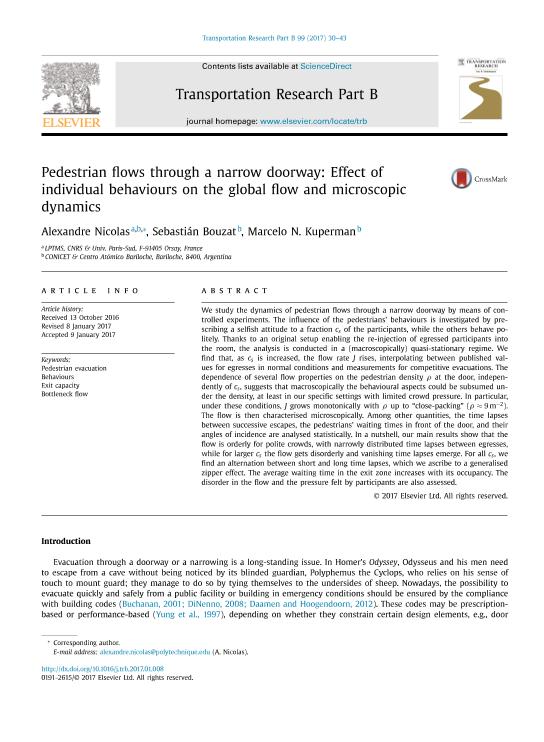Mostrar el registro sencillo del ítem
dc.contributor.author
Nicolas, Alexandre

dc.contributor.author
Bouzat, Sebastian

dc.contributor.author
Kuperman, Marcelo Nestor

dc.date.available
2018-12-03T14:16:13Z
dc.date.issued
2017-05-20
dc.identifier.citation
Nicolas, Alexandre; Bouzat, Sebastian; Kuperman, Marcelo Nestor; Pedestrian flows through a narrow doorway: Effect of individual behaviours on the global flow and microscopic dynamics; Pergamon-Elsevier Science Ltd; Transportation Research Part B-methodological; 99; 20-5-2017; 30-43
dc.identifier.issn
0191-2615
dc.identifier.uri
http://hdl.handle.net/11336/65572
dc.description.abstract
We study the dynamics of pedestrian flows through a narrow doorway by means of controlled experiments. The influence of the pedestrians’ behaviours is investigated by prescribing a selfish attitude to a fraction cs of the participants, while the others behave politely. Thanks to an original setup enabling the re-injection of egressed participants into the room, the analysis is conducted in a (macroscopically) quasi-stationary regime. We find that, as cs is increased, the flow rate J rises, interpolating between published values for egresses in normal conditions and measurements for competitive evacuations. The dependence of several flow properties on the pedestrian density ρ at the door, independently of cs, suggests that macroscopically the behavioural aspects could be subsumed under the density, at least in our specific settings with limited crowd pressure. In particular, under these conditions, J grows monotonically with ρ up to “close-packing” (ρ≈9m−2). The flow is then characterised microscopically. Among other quantities, the time lapses between successive escapes, the pedestrians’ waiting times in front of the door, and their angles of incidence are analysed statistically. In a nutshell, our main results show that the flow is orderly for polite crowds, with narrowly distributed time lapses between egresses, while for larger cs the flow gets disorderly and vanishing time lapses emerge. For all cs, we find an alternation between short and long time lapses, which we ascribe to a generalised zipper effect. The average waiting time in the exit zone increases with its occupancy. The disorder in the flow and the pressure felt by participants are also assessed.
dc.format
application/pdf
dc.language.iso
eng
dc.publisher
Pergamon-Elsevier Science Ltd

dc.rights
info:eu-repo/semantics/openAccess
dc.rights.uri
https://creativecommons.org/licenses/by-nc-sa/2.5/ar/
dc.subject
Behaviours
dc.subject
Bottleneck Flow
dc.subject
Exit Capacity
dc.subject
Pedestrian Evacuation
dc.subject.classification
Astronomía

dc.subject.classification
Ciencias Físicas

dc.subject.classification
CIENCIAS NATURALES Y EXACTAS

dc.title
Pedestrian flows through a narrow doorway: Effect of individual behaviours on the global flow and microscopic dynamics
dc.type
info:eu-repo/semantics/article
dc.type
info:ar-repo/semantics/artículo
dc.type
info:eu-repo/semantics/publishedVersion
dc.date.updated
2018-10-29T15:11:00Z
dc.journal.volume
99
dc.journal.pagination
30-43
dc.journal.pais
Países Bajos

dc.journal.ciudad
Amsterdam
dc.description.fil
Fil: Nicolas, Alexandre. Consejo Nacional de Investigaciones Científicas y Técnicas. Centro Científico Tecnológico Conicet - Patagonia Norte; Argentina. Comisión Nacional de Energía Atómica. Centro Atómico Bariloche; Argentina. Centre National de la Recherche Scientifique; Francia
dc.description.fil
Fil: Bouzat, Sebastian. Consejo Nacional de Investigaciones Científicas y Técnicas. Centro Científico Tecnológico Conicet - Patagonia Norte; Argentina. Comisión Nacional de Energía Atómica. Centro Atómico Bariloche; Argentina
dc.description.fil
Fil: Kuperman, Marcelo Nestor. Consejo Nacional de Investigaciones Científicas y Técnicas. Centro Científico Tecnológico Conicet - Patagonia Norte; Argentina. Comisión Nacional de Energía Atómica. Centro Atómico Bariloche; Argentina
dc.journal.title
Transportation Research Part B-methodological

dc.relation.alternativeid
info:eu-repo/semantics/altIdentifier/doi/https://dx.doi.org/10.1016/j.trb.2017.01.008
dc.relation.alternativeid
info:eu-repo/semantics/altIdentifier/url/https://www.sciencedirect.com/science/article/pii/S0191261516307548
Archivos asociados
